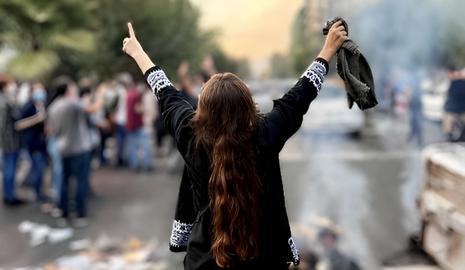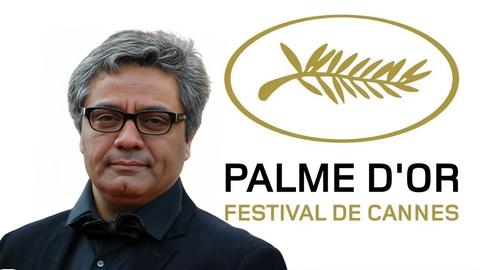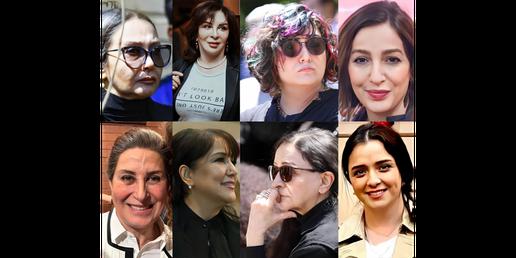It has been almost a year since the “Woman, Life, Freedom” movement started with unprecedented nationwide protests over the death of Mahsa Amini in the custody of the Islamic Republic’s morality police. Since then, we have witnessed fundamental changes in the demands of Iranian society, the methods of struggle and the relationship between the people and the government.
However, this protest movement, along with the November 2019 protests, has deeply affected other aspects of the struggle in Iran such as reporting, recording and documenting human rights violations, and has opened a new path.
A Human Rights Revolution
The revolution that started as an angry reaction to the murder of Mahsa Amini over forced hijab and in protest against violating the human right to choose and human dignity, turned into a full-fledged human rights revolution with the main slogan of "Woman, Life, Freedom." Each word in this slogan points to a pillar of the fight for human rights: “Woman” as the representative of all groups that suffer from discrimination in Iran and as the largest group among the victims of discrimination, “Life” as the most fundamental human right, a right that without it all other rights are meaningless, and “Freedom” which guarantees the right of choice and human dignity.
This unique aspect of the protests raised the world’s interest in the situation of human rights in Iran and, perhaps for the first time, this interest went beyond the governments and human rights organizations and engaged the public opinion of the whole world. In turn, this heightened attention led to more extensive and in-depth reporting which changed the type and form of reporting human rights violations in Iran.
The audiences for reports on human rights violations in Iran were no longer limited to the governments and international organizations that monitor human rights. As a result, detailed reports of human rights violations by the Islamic Republic, filled with legal jargon, were no longer enough for the new audiences and the new atmosphere.
What is more, the human rights record of the Islamic Republic was no longer just discussed at the United Nations or in closed-door meetings attended by government officials of democratic countries but also on social media, which have become the most important platform for reporting on human rights violations in Iran.
In response to this new situation, tens of thousands of multimedia pieces, often in foreign languages, were produced by citizens and published on social media, which introduced millions of people around the world to the realities of life under the rule of the Islamic Republic and the full range of discrimination and human rights violations in Iran.
For the first time, many misconceptions about the nature of the Islamic Republic and the situation of human rights in Iran, which were the product of government propaganda and whitewashing by the Islamic Republic's lobbies in the western media, were corrected.
One of the most important features that was added to the process of documenting human rights violations as a result of the citizens’ more active participation was more focus on narrative and stories. Stories of human rights abuses, especially when they focus on individual victims, not only draw more attention to human rights issues in Iran but also make the situation in Iran more tangible for audiences who are unfamiliar with the country. More importantly, stories of human rights violations are a very effective tool against the propaganda of agents of the Islamic Republic in the Western media which, until recently, was the most powerful voice that told non-Iranian audiences about what was going on inside the country.
It is likely that the changes in the format and the media for reporting human rights violations will gradually change the traditional formats for doing so by governments and international monitoring organizations as well. The multimedia format, which is more effective and at the same time more concise, can be a suitable alternative to long, written official reports, especially in advocacy campaigns that must have the greatest amount of influence on decision makers and policy makers within the shortest possible time.
Citizen Instead of Media and Human Rights Organizations
Documenting and reporting human rights violations in countries that are committed to international human rights laws and where the rule of law is established, has a clear and specific process. Human rights monitoring organizations, called "watchdogs", or the media, as one of the basic pillars of ensuring transparency and accountability in governments, can operate and investigate freely. Governments are duty-bound to cooperate with them and provide them with the necessary access to the information needed to conduct independent investigations.
The results of investigations by these watchdogs or the media are published for the general public, and then the government takes measures based on these reports to rectify any damages and to guarantee and protect human rights more rigorously. If the government's actions in this regard fall short and are not satisfactory, judicial remedies are available and human rights watchdogs can go to court to compel the government to take appropriate action. And if none of these usual channels lead to a full guarantee of human rights, these organizations can try to remedy the situation by campaigning for new laws and by inviting the society to peacefully protest, which is an accepted and protected right in societies committed to human rights.
However, in countries like Iran where the rule of law has no meaning and the government deliberately and persistently violates its international obligations, especially when human rights are concerned, documenting and reporting human rights violations must be done under completely different conditions. On the one hand, the government has banned the activities of human rights watchdogs inside the country by criminalizing them and by bringing baseless and fabricated charges against them. On the other hand, it also actively tries to destroy any evidence of its own violations of human rights. Furthermore, the government uses its repression apparatus and propaganda machine to arrest, intimidate, threaten, defame and even kidnap and kill rights defenders and independent journalists, both inside and outside the country.
Under such conditions, documenting and reporting human rights in Iran faces serious obstacles that affect the speed, scope and accuracy of research. And when the situation becomes more critical, especially as a result of nationwide protests, these obstacles become even more formidable. The Islamic Republic follows a clear pattern in preventing the documentation and the reporting of violations of human rights during protests: it bans all activities by human rights organizations inside the country, uses intimidation, cuts off the internet, steals the bodies of those killed, threatens or arrests eyewitnesses and the families of the victims and increases the activities of its propaganda machine and its whitewashing networks in media outlets outside the country.
In recent nationwide protests, the vacuum that resulted from the absence of human rights watchdogs and independent media outlets in Iran was largely filled by the citizens. In previous years, citizens were only effective in recording images showing the relentless violence used by the security forces, but this time they also shouldered a major part of the burden of documenting human rights violations. In finding and collecting information about the equipment used in repression, about the government officials and individuals who played a direct role in suppressing the protests and also about the connections between the Islamic Republic’s repression apparatus and businesses, citizens played an undeniable role.
New Non-Governmental Organizations
The situation in countries like Iran where the government deliberately violates human rights on a large scale and actively tries to cover evidence of its crimes, has prompted rights defenders to adopt different and creative approaches to recording violations. One of the most effective of these methods has been the collective endeavor to document human rights violations, mainly based on the voluntary activities of the individuals, by training and empowering groups within the society to record and to report human rights issues.
During recent protests, we witnessed the formation of a diverse set of non-governmental groups and organizations that secretly and anonymously record human rights violations and usually focus on a specific set of rights or a specific group of victims. In other words, activities that used to be scattered among individuals, now take place in the framework of small but numerous NGOs. The Committee to Pursue the Status of Detainees is one of the NGOs that has put together one of the most comprehensive lists of names of detainees and their latest status.
Another group includes NGOs founded by the families of victims. These NGOs strive to seek justice for the victims and publicize information about the illegal and criminal harassment of the families by the government’s agents. These groups enjoy a significant level of credibility among the populace and have great ability to mobilize people to collect information and evidence of human rights violations.
Along with organizing protests, small and large revolutionary groups that have emerged across the country have also played a key role in documenting human rights violations and law-breaking by the security forces. Furthermore, during recent protests, some trade unions and labor organizations also played a key role in documenting and reporting human rights violations related to their trade. For example, an important part of the information and evidence about the detention, the torture and the killing of the students was collected, documented and reported through the teachers' unions. Also, information and evidence related to the illegal treatment of workers who went on strike in support of the protests have been recorded and reported by labor organizations.
Furthermore, a number of media outlets and human rights organizations abroad have focused part of their activities on educating and informing non-expert citizens about the standard methods of documenting and reporting human rights violations so that the information collected by these citizens can be verified in accordance with universally accepted principles.
New Ways of Documenting Abuses
At the same time that the format of reports on human rights violations, the audiences for these reports and the people involved in preparing these reports have undergone fundamental changes, so have the tools and methods of documentation have also changed due to the existing obstacles and the emergence of new facilities. The ban on the activities of human rights watchdogs and free media in Iran and the impossibility of conducting independent field investigations by these organizations are the most important obstacles to documenting human rights violations, especially in relation to the suppression of protests. In addition, lack of transparency of government institutions and the inability to access official information has made it more difficult to document human rights violations, especially when it comes to identifying the violators.
These obstacles have led the efforts for documenting rights violations to use information gathering through open source intelligence (OSINT). OSINT applies creative methods to search publicly available sources and makes the information that it gathers available for evaluation and investigation.
OSINT methods are very useful for locating events that pertain to human rights violations, as well as for verifying information that has been published about abuses. These methods are also effective in identifying violators and in collecting their personal information so that they can be prosecuted.
OSINT can lead the way in discovering the truth about an event involving human rights violations. On February 11, 2023, a YouTube channel called Loudspeaker posted a video that was the product of an anonymous group's research into the attack by government agents on students of Tehran’s Sharif University of Technology on October 2, 2022. By collecting, verifying and putting together all the videos that were posted on the day and the night of October 2, they created a narrative of the events from various angles. This video was a significant help in clarifying the dimensions of the attack on the university students.
In recent protests, in addition to OSINT which only employs authorized methods of using publicly available resources, activist hacker groups or “hacktivists” also played a key role in documenting human rights violations. In the past, the activities of these groups were focused only on punitive measures and sabotage by deactivating government websites or by posting anti-government content on these websites. But in recent years they have increasingly focused on gathering information that can be used for documenting government crimes. The release of CCTV footage from inside Iranian prisons which has proved the systematic use of torture in these prisons, the leak of internet filtering documents and the documents of the Foreign Ministry and the office of the president in connection with the suppression of protests have played an important role in recording human rights violations and help us understand the hierarchy structure involved and identify rights violators.
On the whole, it appears that a new era for human rights activism and for documenting and reporting abuses has come, an era in which the success of documenting rights violations in dictatorial countries requires a change in approach and the modernization of tools and methods of activity. The growth in the size of audiences for human rights reports has increased the need for using multimedia formats and for focusing on the stories in documentation processes. The most important need in this new era, however, is the development of collective methods and providing educational and technical support for citizen groups who want to be more active in documenting and reporting events related to human rights.
visit the accountability section
In this section of Iran Wire, you can contact the officials and launch your campaign for various problems






















comments